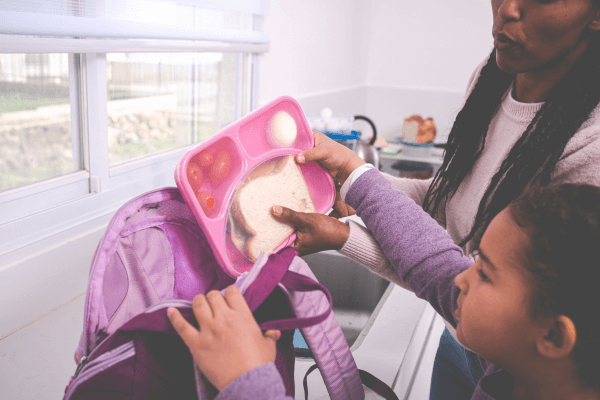Back to School Packing Lunches
It’s back to school season, which means for most families that it’s time to pack lunches. Packing lunches can feel like a challenge trying to balance nutrition, budget, variety, food safety, and figuring out what your kids will actually eat. Here are a few tips for streamlining the task of packing lunches.

Get your kids involved – Involve your kids in the decision making and preparation. Decision making can start at the grocery store with simple decisions, for example, “would you like bananas or oranges in your lunch this week?”. When kids can be involved in some planning and decision making about meals, there is a better chance they will enjoy what’s packed! Involving kids in packing lunches also teaches important life skills like meal preparation, grocery shopping, as well as helping them discover their own preferences, and build a healthy relationship with food.
Make lunches the night before – Mornings are busy! Make life easier by packing lunches the night before. Pack lunches while cleaning up supper, especially easy if the leftovers can be packed in lunches.
Pack foods your kids like – Packed lunches are not the place to get your kids to try new foods. Save trying new foods for when they are at home, and in a relaxed environment. Pack foods that you know your kids like, even if that means packing the same items every day. This also means including food items that are just for fun. Different foods have different purposes, some foods purpose is enjoyment. Making these foods scarce only makes them more exciting to kids, and makes them want them more, which can cause a power struggle between the parent and child. When these “fun foods” are available in packed lunches regularly, eventually your child will see them as just another packed item, and will reduce their perceived “obsession” with them. In the long run, this will help kids develop a healthier relationship with food, and help them not feel out of control around these foods when exposed to them as a child, teen, and into adulthood.
Everyone has a job – Feeding kids can be a challenge, and meal times can feel like a power struggle if not everyone knows their job. According to Ellyn Satter, parents and kids each have a job to do at mealtime. At home it’s the parent’s job to provide food regularly, and to decide what, when, and where food is provided for their kids. At home it’s the child’s job to decide if they are going to eat what is provided, and how much. At school, the jobs shift a little. At school, it’s the parent’s job to decide (with input from the child) what is packed in the lunch, it’s the child’s job to decide if they are going to eat what is packed, in what order, and how much, and it is the teacher’s job to decide when and where the food is eaten. This may mean that your child doesn’t eat everything in their lunch or on their plate, but it helps your child learn to understand and listen to their own hunger cues, helping them develop a healthy relationship with food.
Pack a variety of foods – Some kids eat a larger variety of foods than others, and that is ok. Kids are still learning about different foods and their preferences. Here is a lunch checklist to include different important nutrients. If kids are given a snack time at school, don’t forget to pack enough for lunch and snacks.
- Protein food
- Whole grain carbohydrate food
- Fruit and/or vegetable
- Fun food
- Water
Examples:
Homemade “Lunchables”
- Sliced meat and cheese
- Whole grain crackers
- Baby carrots and grapes
- Banana chocolate chip muffin
- Water
Sandwich
- Tuna salad sandwich
- Whole grain bread
- Snap peas and fruit cup
- Brownie
- Water
Leftovers
- Chicken noodle soup in a thermos, hummus or tzatziki for crackers and celery
- Whole grain crackers
- Celery sticks and mandarin orange
- Gummies
- Water
Don’t forget food safety – Use ice packs and thermoses to keep foods at a safe temperature until lunch time.

